By: Susan McKee
Yerevan is disconcerting. At first glance, Armenia’s largest city looks like any European capital – bustling streets, tall buildings, lots of shopping and an atmosphere of purposeful hustle. When I first arrived, I walked outside my hotel and looked around at Republic Square. Beside me was a chic sidewalk café filled with smartly dressed men and women. In front, pedestrians expertly dodged traffic as they crossed the pavement.
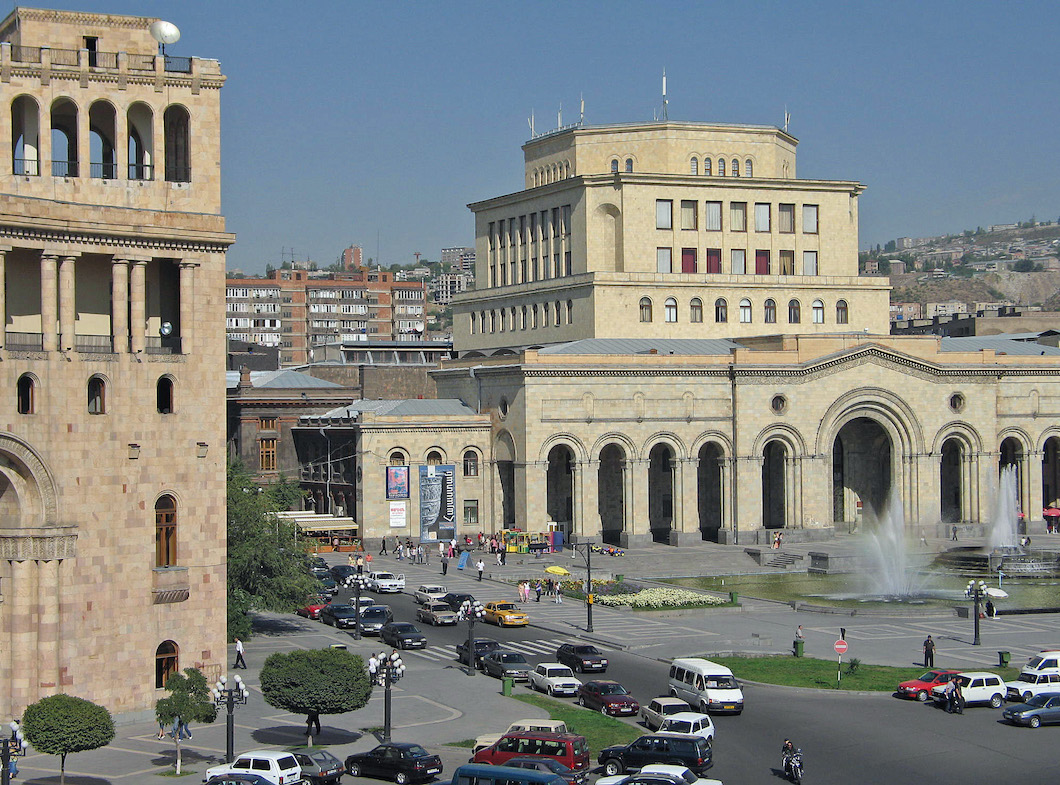
Armenia’s capital of Yerevan radiates out from Republic Square, which is limned by elegant limestone buildings, the most impressive of which is the National Gallery
The square itself has five major buildings that include Government House, where the Prime Minister lives, and the National Gallery. Built of pink and yellow limestone, they are neoclassical in design and decorated with geometric Armenian motifs.
Aside from the architecture, however, I found the city indecipherable. I couldn’t read the street names or shop signage because I didn’t recognize the letters of the Armenian alphabet. It was invented in 405 AD by Mesrop Mashtots, a monk versed in both Persian and Greek who was secretary to King Khosrov IV. Who were these people?

Mickey spent months studying fifth century monk Mesrop Mashtots and eventually learned to understand Armenia’s unique language
To learn more I headed for the Matenadaran, a massive basalt building that looms over Mashtots Boulevard – a street called Lenin Prospect during the Soviet era. It houses more than 23,000 intricately illuminated manuscripts and 500,000 other documents, the written record of Armenia’s culture. The museum part of the Matenadaran is divided into thematic exhibitions that include medieval medicine and ancient maps. Fortunately for visitors, guided tours are available in nine languages.
My next stop was the Yerevan Museum of Folk Art. From embroidery and lace making to ceramics and woodwork, centuries of Armenian handicraft are on display. The country is very proud of its carpetmaking which has distinctly Persia roots and dates back to the fourth century BC. Perhaps this explains why so many Armenians are rug merchants.
After all this culture I needed a drink, so I headed to an Armenian brandy factory called Ararat. The legendary elixir is distilled from Armenian grapes grown in the Tavush region of the Ararat Valley. In the tasting room I was able to savor the sweetness of the grapes. Unfortunately, the tasting room is temporarily closed because of Covid-19.
There is an old saying that the Armenians have their minds in the west and their hearts in the east. Perched on the cultural boundary between Europe and Asia, Armenia is an ideal destination for the traveler who is looking for the exotic in a somewhat familiar setting. If you speak a bit of Russian it will come in handy. Armenia’s second language is Russian, and while use of English is growing, it’s still not spoken in every hotel, restaurant and shop. The evidence of Armenia’s membership in the Soviet Union is omnipresent. Signs throughout downtown Yerevan bear both Armenian and Cyrillic characters and heroic Socialist architecture is the norm.
It’s estimated that there are 11 million Armenians in the world, but fewer than a third live in their homeland – a country much smaller than its historic reach.
When the Soviet Union dissolved, many Armenians returned to their ancestral homeland, money and Western skillsets in hand, to help fuel modernization. Several people in Yerevan told me that Hollywood mogul Kirk Kerkorian personally paid for hundreds of miles of new highways, built to American freeway standards. Four Armenian-Americans from Boston, MA launched the Marriott on Republic Square, the first American-brand hotel in Yerevan.
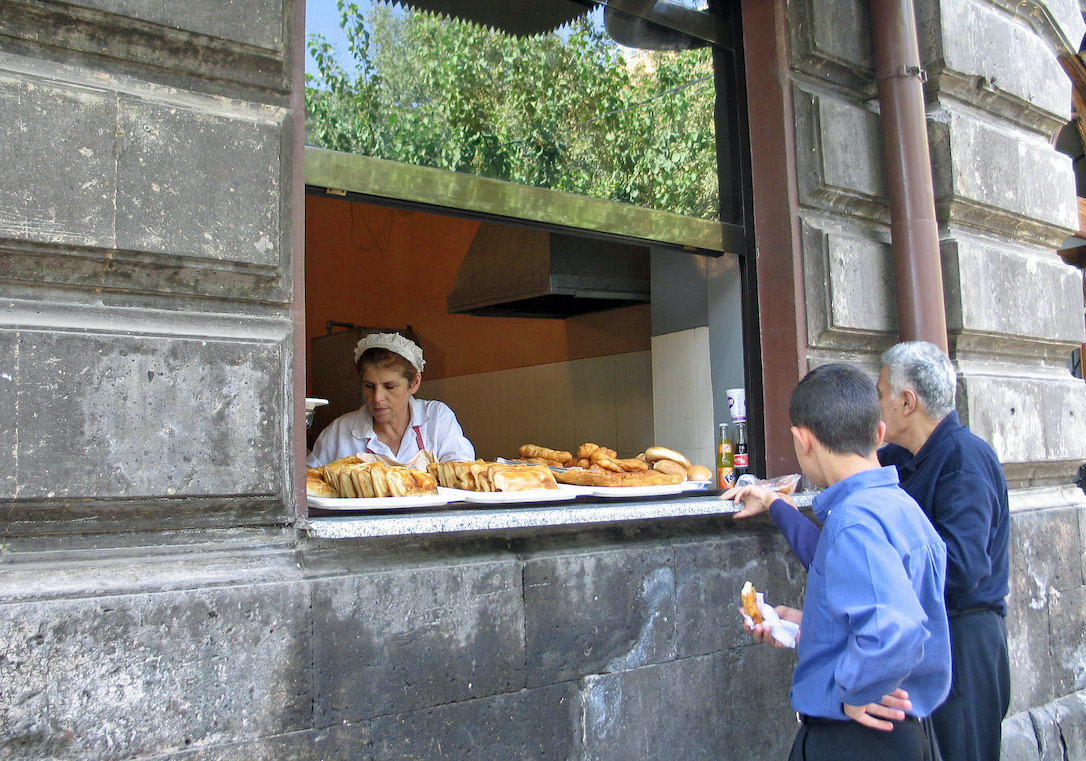
Leafy Abovian Street is lined with restaurants, office buildings and shops ranging from the latest styles from Western Europe to household essentials such as bread — sold from storefront windows just as it was in medieval times. Baked goods are delicious no matter where they are purchased in Armenia
In 1985, Armenian-American James Tufenkian decided to bring Armenia’s historic tradition of Oriental rugs into the 21st Century. Some of the Tufenkian Artisan Carpets made in Yerevan use wool from Caucasus Mountain sheep and employ the traditional Persian Senneh knot, but nearly 80% come from Nepal. Profits from the carpet company (with stores throughout the United States and England) and the four Tufenkian Heritage Hotels in Armenia fund the Tufenkian Foundation.
Perhaps the flashiest investments in Yerevan were made by Gerard L. Cafesjian, a Brooklyn-born Armenian-American businessman. Through the Cafesjian Family Foundation, established when he retired as executive vice president of West Publishing, he spent some $128 million on projects in Armenia, including a new television station and a renewable energy company.
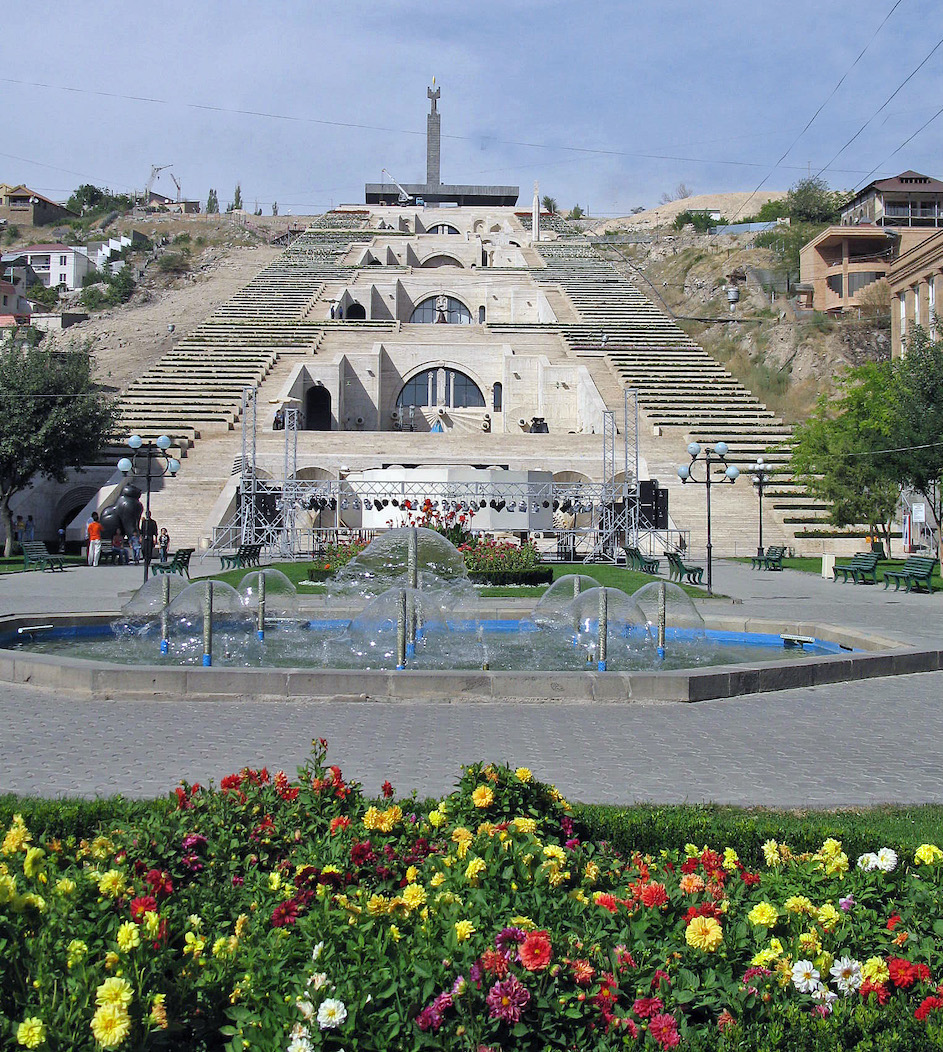
The Cascade is one of the most ambitious works of contemporary architecture undertaken in any of the former republics of the Soviet Union. It contains more than 5,000 works of art that range from drawings and paintings to fanciful sculptures.
The most dramatic is his completion of the Cascade, a multi-level white granite structure begun during Soviet times. This combination garden, fountain and sculpture gallery climbs 30 stories from the Tamayan Street gardens up a steep hill on the northside of downtown Yerevan. Finished in 2009, the Cascade complex houses the Cafesjian Center for the Arts. Its sculpture garden includes whimsical and thought provoking works by world class artists that include Fernando Botero, Lynn Chadwick and Barry Flanagan, among others.
Visitors do not have to climb the 553 steps to the top, however. A series of escalators is hidden on the left side of the Cascade, and there’s no charge to ride up or down.
Near the entrance to Victory Park, across the street from the top of the Cascade, is the massive statue of Mother Armenia, visible from almost everywhere in Yerevan. The figure is made of 72 feet of hammered copper and replaced a statue of Stalin in 1967 that had been erected as a victory memorial for World War II.
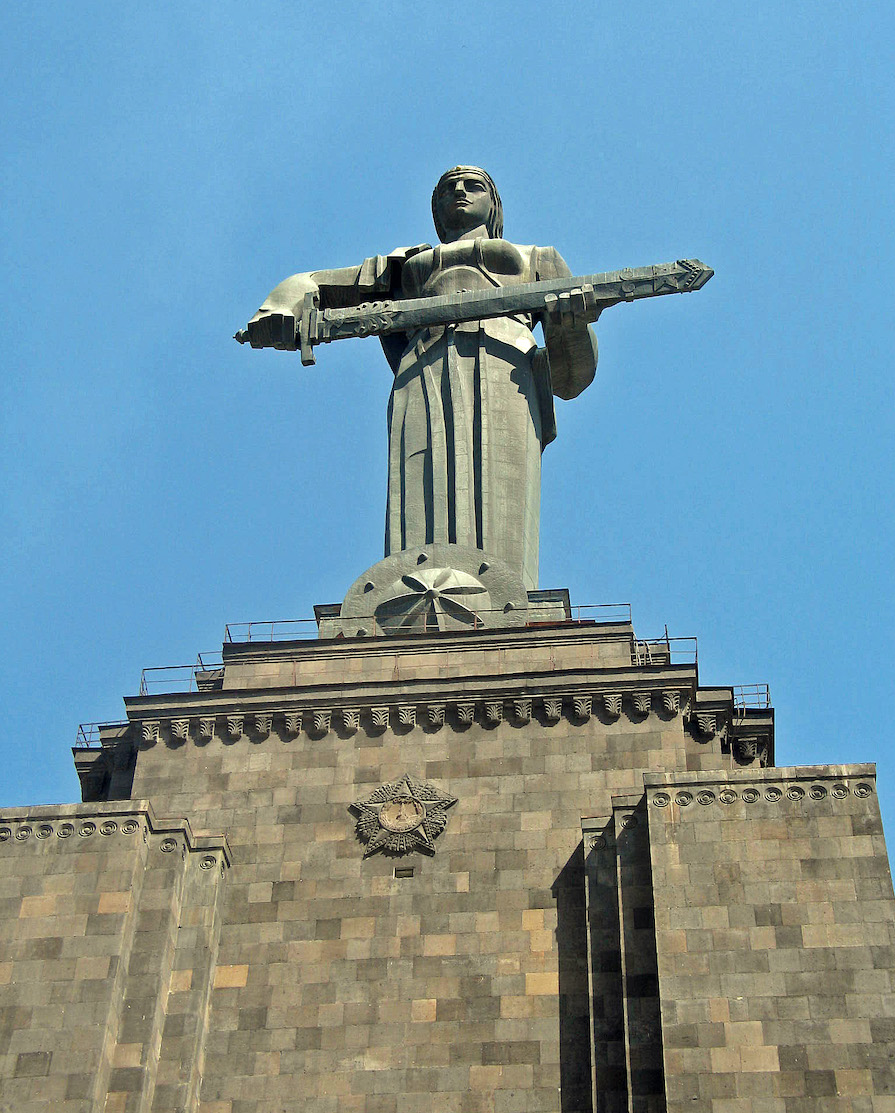
Mother Armenia watches over Yerevan from her perch in in Victory park across from the Cascade. She occupies the spot once held by Josef Stalin
Viewed from the park on a clear day, Mount Ararat seems close enough to touch. The Armenians consider themselves to be the descendants of Noah, whose ark famously beached on Ararat’s peak after the flood. This fabled mountain is the historic heart of the ancient Armenian empire, and the fact that it lies almost 34 miles away, across the (now-closed) border in Turkey, is a touchy subject.
Before World War I, Armenia was six times larger than now. The region known as the “Armenian Highlands” included not only its present location, but much of the northern Caucuses (Georgia/Azerbaijan/Southern Russia), Anatolia (Eastern Turkey), Ancient Mesopotamia (Northern Iraq), the Levant (Southeast Turkey/Syria/Jordan/Lebanon), and the Iranian Plateau. According to geneticists, ethnic Armenians are of southwest Asian ancestry. In the United States, they are counted in the minority race category Middle Eastern/North African (or “MENA”) for the 2020 census.
Centuries of military defeat and persecution moved the boundaries inward and scattered the population. Today’s Armenia it is bordered on the north by Georgia (84% Eastern Orthodox), on the east by Azerbaijan (mostly Shi’a Muslim), and on the south and west by Shi’a Iran and Sunni Turkey.
The modern Armenian diaspora largely was created as a result of World War I, when the genocide ordered by the Ottoman Empire forced Armenians living in what is now Turkey to flee or be killed. In the years around 1915, hundreds of thousands of Armenians died or emigrated – a genocide still hotly denied by the current Turkish government.
A visit to the somber Genocide Memorial and Museum at Tsitsernakaberd gives dramatic testimony about the destruction of the Armenian communities of Eastern Anatolia. The genocide remains fresh in the collective memory of Armenians, and the eternal flame in the memorial is usually surrounded by fresh flowers brought by visitors. English-language signage in the museum, completed in 1995, provides an introduction to the catastrophic event.
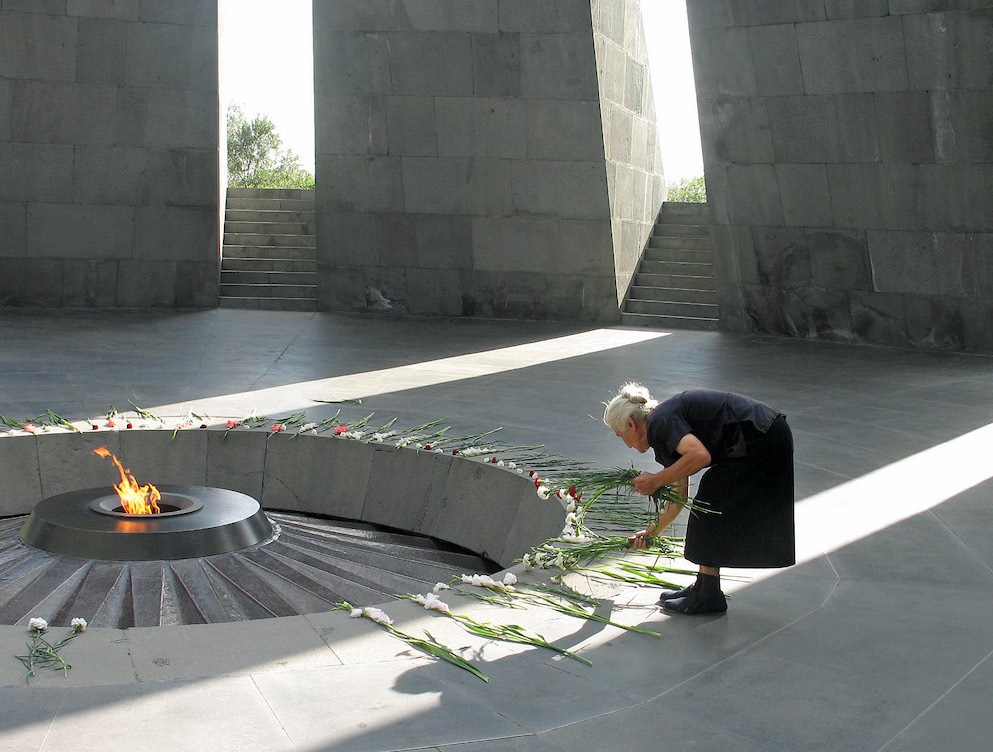
The Genocide Memorial and Museum at Tsitsernakaberd solemnly commemorates the 1915 death and displacement of thousands of Armenians living in Eastern Anatolia. In 2019, both the U.S. House of Representatives and Senate recognized the genocide with resolutions that received overwhelming support
More than a century has passed since Medz Yeghern – “The Great Crime.” It started April 24, 1915, when Ottoman authorities arrested and summarily executed some 250 leading Armenians living in Constantinople (now Istanbul). Then, during the years of WW I, there was the systematic slaughter and forced deportation of millions of Greek and Assyrian Christians then living in Ottoman territories, as well as ethnic Armenians.
Armenia is fiercely proud to claim its status as the first Christian county in the world. The majority, in their homeland or abroad, are members of the Armenian Apostolic Church, a Christian denomination dating to 301 AD (three decades before the Emperor Constantine declared Christianity the state religion of Rome). It’s one of the Oriental Orthodox Churches that also include the Syriac, Coptic, and Ethiopian Orthodox — a distinctly different tradition than the Eastern Orthodox. During the Soviet era from 1922 to 1991, some churches were closed or destroyed, but since independence, there has been a resurgence of interest in Christianity due to the country’s distinct ethnic and religious homogeneity.
Almost all of the Armenia’s Muslims left during Yerevan’s war with majority-Muslim Azerbaijan a decade ago. The only remaining mosque in Yerevan, Gök-Jami (built in 1765) was restored with grants from the Iranian government. Visitors can see the fine tile work of the portal and minaret along Mashtots Boulevard.
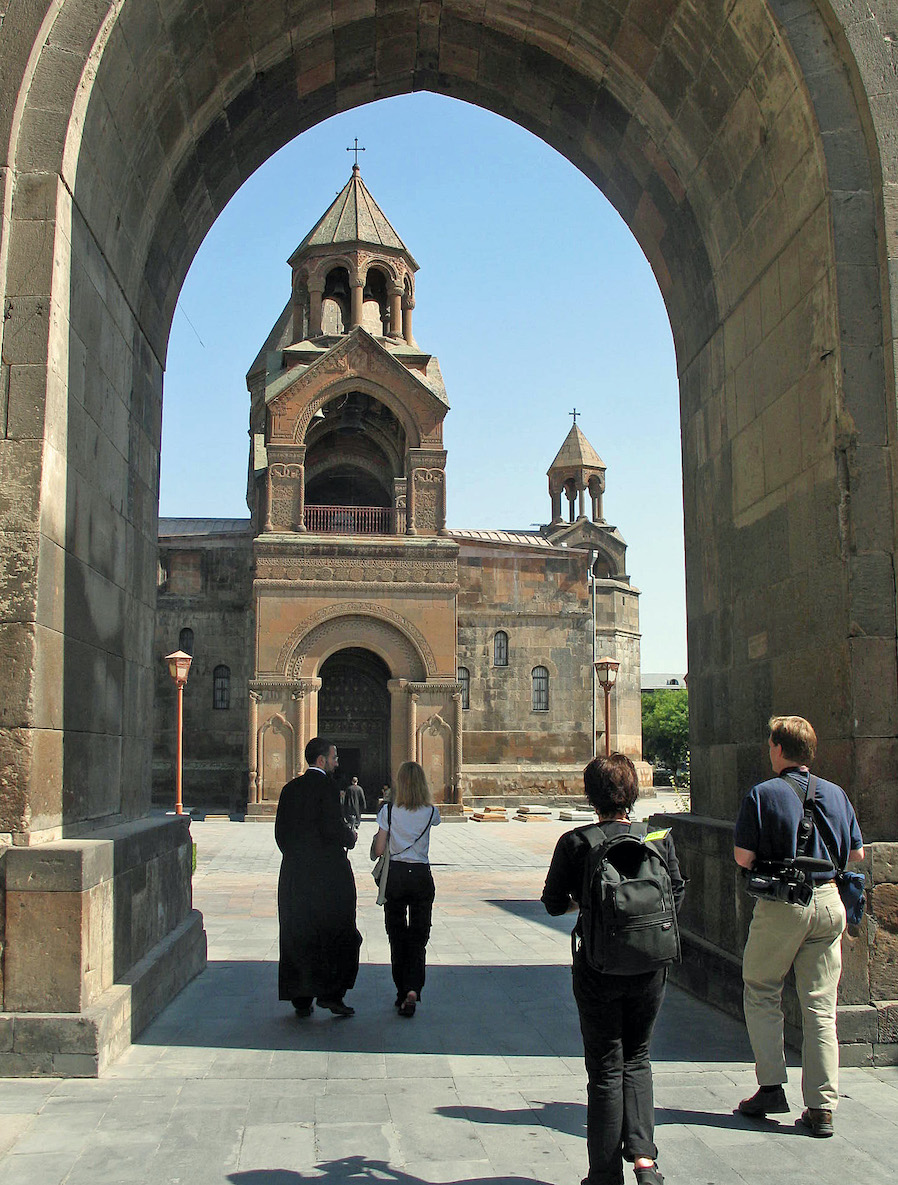
Considered to be the oldest cathedral in Christendom (construction began about 303 AD), Etchmiadzin is the administrative center of the Armenian Apostolic Church and the spiritual center of the Armenian people.
About 12 miles west of Yerevan is the town of Echmiadzin, also called Vagharshapat, the seat of the Armenian Apostolic Church, and now a UNESCO World Heritage Site. The original cathedral was built between 303 and 305 AD by Armenia’s patron saint Gregory the Illuminator, following the adoption of Christianity as a state religion by King Tiridates III. The cathedral was erected over a pagan temple, symbolizing (as churches often do throughout the Mediterranean region) the conversion of the king, and then the entire population, from paganism to Christianity.
Although much of the church’s wealth “disappeared” during the Soviet era, its most prized relic, a piece of Noah’s Ark, remains to make a visit to the cathedral’s treasury worthwhile.
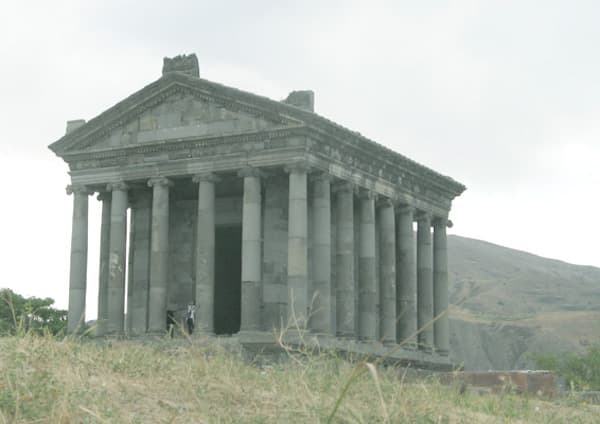
The only surviving pagan sanctuary in Armenia is a classical temple at Garni, set high on a cliff. The small cella, or interior space, is surrounded by a single row of columns, 24 in all, each with a different capital.
Garni, a village in the Kotayk Province, is best known for its temple dedicated to the pagan sun god Mihr. Constructed in the 1st Century AD (and “reconstructed” between 1969 and 1975), it is the only free-standing Greco-Roman structure remaining in the country. The gray basalt colonnaded building is a tangible reminder of Armenia’s connections to those ancient civilizations when Armenia extended not only to the Black Sea, but all the way to the Mediterranean around the south side of Anatolia as well.
Geghard Monastery, a UNESCO World Heritage Site, is seven miles northeast along the Azat River from Garni. Most of the churches and tombs dating from the 4th to the 13th centuries are cut into the mountain rock and are considered the peak expression of Armenian medieval architecture. According to tradition, the monastery was founded by St. Gregory the Illuminator, the key figure in Armenian Christianity.
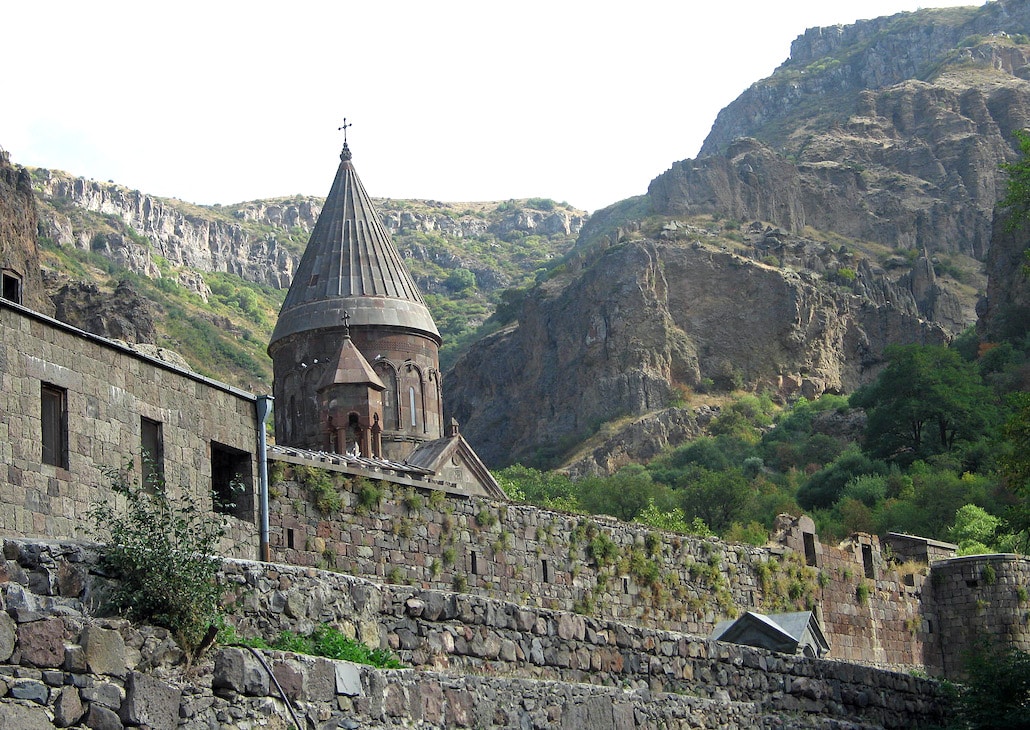
St. Gregory slept here. Both solemn and spiritual, Geghard Monastery is worth a visit, if only to sample the delightful confections of of local vendors
To the south – almost to the modern border with Turkey — is Khor Virap. Here, St. Gregory the Illuminator was consigned to the “pit of oblivion’ in 288 AD for the crime of preaching Christianity. He spent 13 years virtually entombed underground – “maintained by angels” — until Khosrovidukht, a sister of King Tiridates the Great, had a vision. Only Gregory could cure the king of lycanthropia. Yes, the king was a werewolf! Pulled from the pit, the saint managed to cure him and, perhaps in gratitude, the king converted to Christianity. St. Gregory is recognized as the founder of the Armenian Apostolic Church.
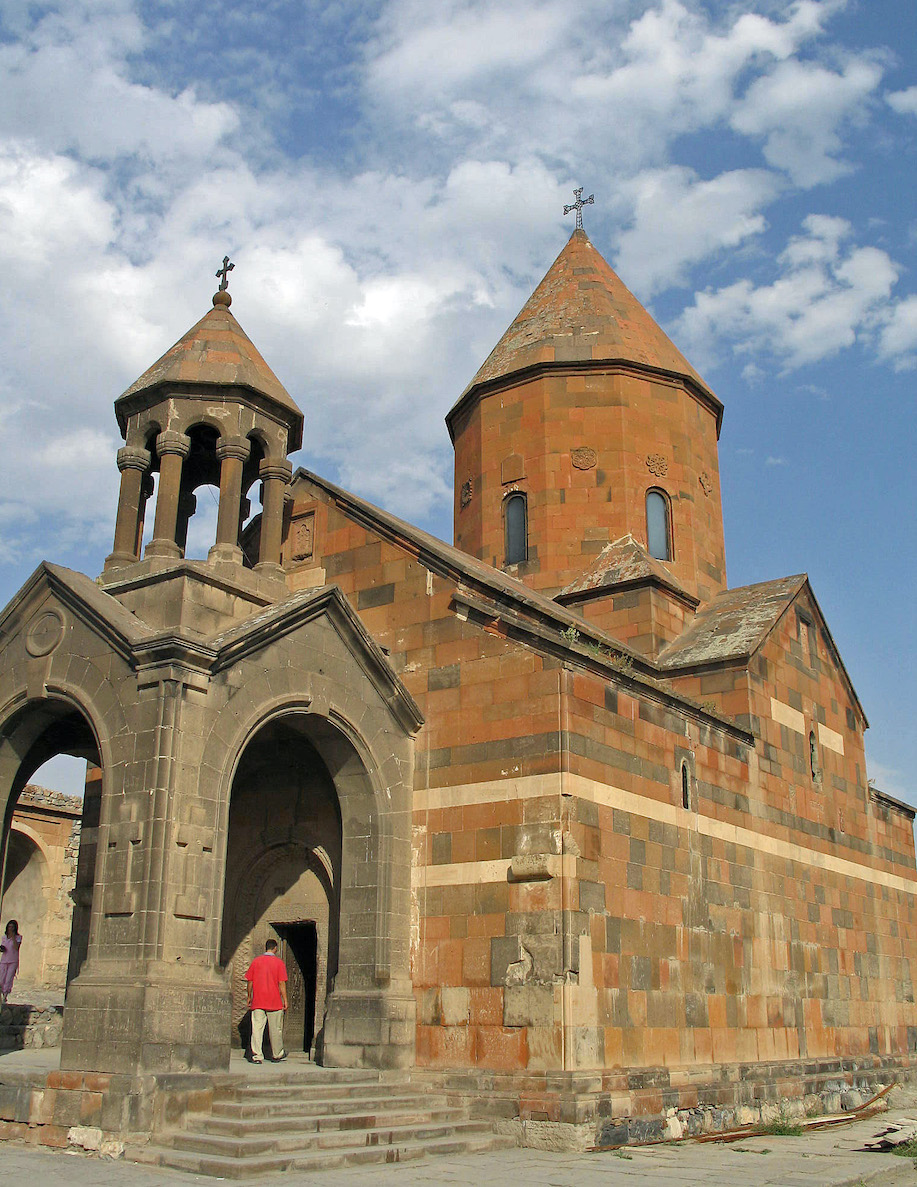
St. Gregory’s “pit of oblivion” beneath a church at Khor Virap retains its menace. Descending three or four stories beneath the earth to a windowless, airless, stonewalled chamber – even one that now has electric lights and a modern ventilation system – gives a glimpse at the terror of a confinement that was meant to be terminal. St. Gregory was imprisoned for 13 years. According to legend, he survived his ordeal with the help of angels
Of course, a sanctuary was built atop the pit, which is still preserved in the monastery complex. I was one of the intrepid visitors who climbed down the 27 rungs of a metal ladder bolted to one side of a narrow shaft into the underground room where the saint said he was sustained by angels. Such a hazardous descent would never be permitted in the United States.
The official tourism website for the country is Armenia.travel. The Yerevan Tourism Card wasn’t available when I was there, but if you go, it’s probably worth getting because it includes admission to museum, restaurant discounts, and transportation.
Writer and photographer Susan McKee travels the world from her base in Indianapolis, Indiana

